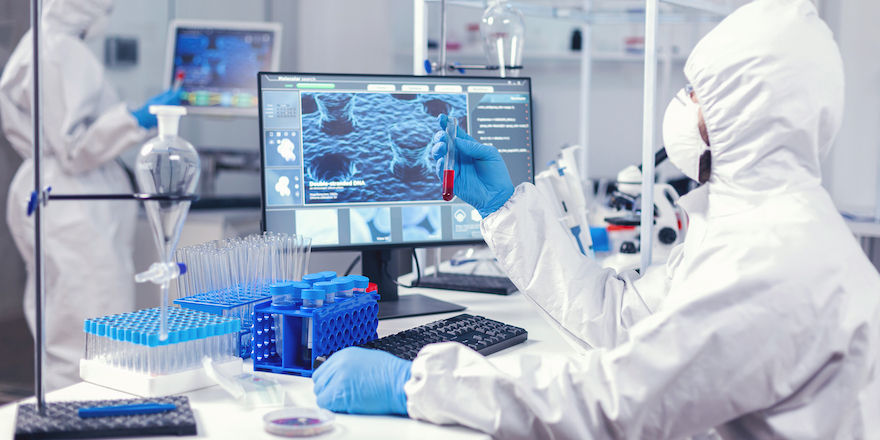
Are you ever curious about what happens behind the scenes when you give blood or other samples? What happens to it and how can the doctor tell what’s wrong just from that little sample? What you don’t see are the tests and analyses that medical laboratory technologists do to help determine a diagnosis. So, if this is something that interests you, then you should consider becoming a medical laboratory technologist (MLT)!
What is a medical laboratory technologist?
A medical laboratory technologist performs tests and experiments on patients to assists physicians and nurses with patient diagnosis, treatment, monitoring, and care. Medical laboratory technologists typically work in hospitals, clinics, research facilities, blood banks, and post-secondary educational institutions.
What do medical laboratory technologists do?
Medical laboratory technologists examine samples from patients, such as blood, fluids, and tissue, for pathogens, abnormalities, and reactions to drugs. More specifically, MLTs will use laboratory equipment to perform tests to analyze blood cell counts, iron levels, DNA matching, hemoglobin levels, urinalysis, and more. Medical laboratory technologists can also interpret a patient’s blood group, type, and compatibility for transfusion purposes. Essentially, anything that needs to be tested from a patient and studied will go to a medical laboratory technologist.
Check out what a day in the life of a medical laboratory technologist is like:
How to become a medical laboratory technologist in three short steps:
Get your dream career in healthcare in three simple steps:
Step one: Education
The first step to becoming a medical laboratory technologist is to have the right education. Luckily, you have options when it comes to your schooling. Depending on what you prefer, you could choose between a college diploma or bachelor’s degree at a university in programs like Medical Laboratory Technologist and Medical Laboratory Science. An example of some schools that have these programs are:
When selecting your program, you should consider if the program offers a clinical practicum, field placement, or co-op where you can gain experience working alongside professionals. In most provinces, a period of supervised practical training may be required to be licensed.
As a bonus, if you’re considering studying in an MLT program for the fall of 2023, the Ontario government has created the Learn and Stay Grant which could cover your tuition costs!
Step two: Take the national certification examination
Once you graduate from your program, you’ll be eligible to write the national certification examination from the Canadian Society for Medical Laboratory Science (CSMLS). This exam is required for you to work as an MLT in Canada. You must write the exam within a year of your graduation.
The CSMLS MLT exam contains multiple-choice questions and can take up to 3.5 hours to write either in-person or remotely. Check out how the CSMLS recommends you prepare for the exam on top of what you’ve learned in school.
Step three: Register with your province’s regulatory authority
Once you’ve passed the CSMLS MLT exam, you’ll be able to register with the province you’d like to work in and their regulatory authority. You’ll need to do this in order to practice as a medical laboratory technologist. To find out where you should register in each province, check out this list of provincial regulatory authorities.
What’s the difference between a medical laboratory technologist and a medical laboratory technician/assistant?
While medical laboratory technicians/assistants work under the supervision of medical laboratory technologists, there are two main differences that set these careers apart:
| | Medical laboratory technologist | Medical laboratory technician |
| Education | Medical laboratory technologists require more education than medical laboratory technicians. MLTs have a two-to-four-year undergraduate degree in Medical Laboratory Science or Medical Laboratory Technologist. You’ll complete a period of practical training where you’ll work alongside professionals. The credentials an MLT receives will allow you to perform advanced lab testing in more diverse laboratory workplaces. For example, an MLT could work in cancer research or immunology. | Medical laboratory technicians typically earn a degree in a related science field or a certificate in medical laboratory technician. Many of these degrees will provide opportunities for field placements where you can experience the day-to-day duties of a lab technician. Medical laboratory technicians have a limited ability to specialize in areas like blood collection and hematology, whereas there are many more specialization options for MLTs. |
| Level of complexity | Medical laboratory technologists are able to perform complex laboratory tests. For example, you could use advanced equipment to identify and diagnose cancer cells. You’ll often collaborate with doctors to help diagnose patients. | Medical laboratory technicians will act as support for MLTs. You’ll perform pre-analysis and pre-testing tasks such as collecting blood and other samples, processing specimens, and preparing special chemicals for use in testing. Typically, medical laboratory technicians interact with patients more as you collect and prepare samples for MLTs to analyze. |
| Salary | In Canada, medical laboratory technologists earn approximately $36 an hour on average. For more information on salaries, check out how much MLTs make in each province. | In comparison, medical laboratory technicians earn about $26 an hour on average. Explore what medical laboratory technicians make in each province. |
Career prospects of medical laboratory technologists
So, if a career as a medical laboratory technologist sounds like the dream for you, but now you’re wondering what you should expect after you graduate. Take a peek at where you could possibly end up working by checking out the Canadian Government’s Job Bank for MLT openings. Currently, there are about the same number of job seekers as there are openings. You’re also probably wondering how much money does a medical laboratory technologist make? Discover the low, average, and high salary expectations of an MLT.
Now that you have a better understanding of what a medical laboratory technologist is and know all about what it takes to become one, will you choose a career as a medical laboratory technologist?
Learn more about a career as a medical laboratory technologist
